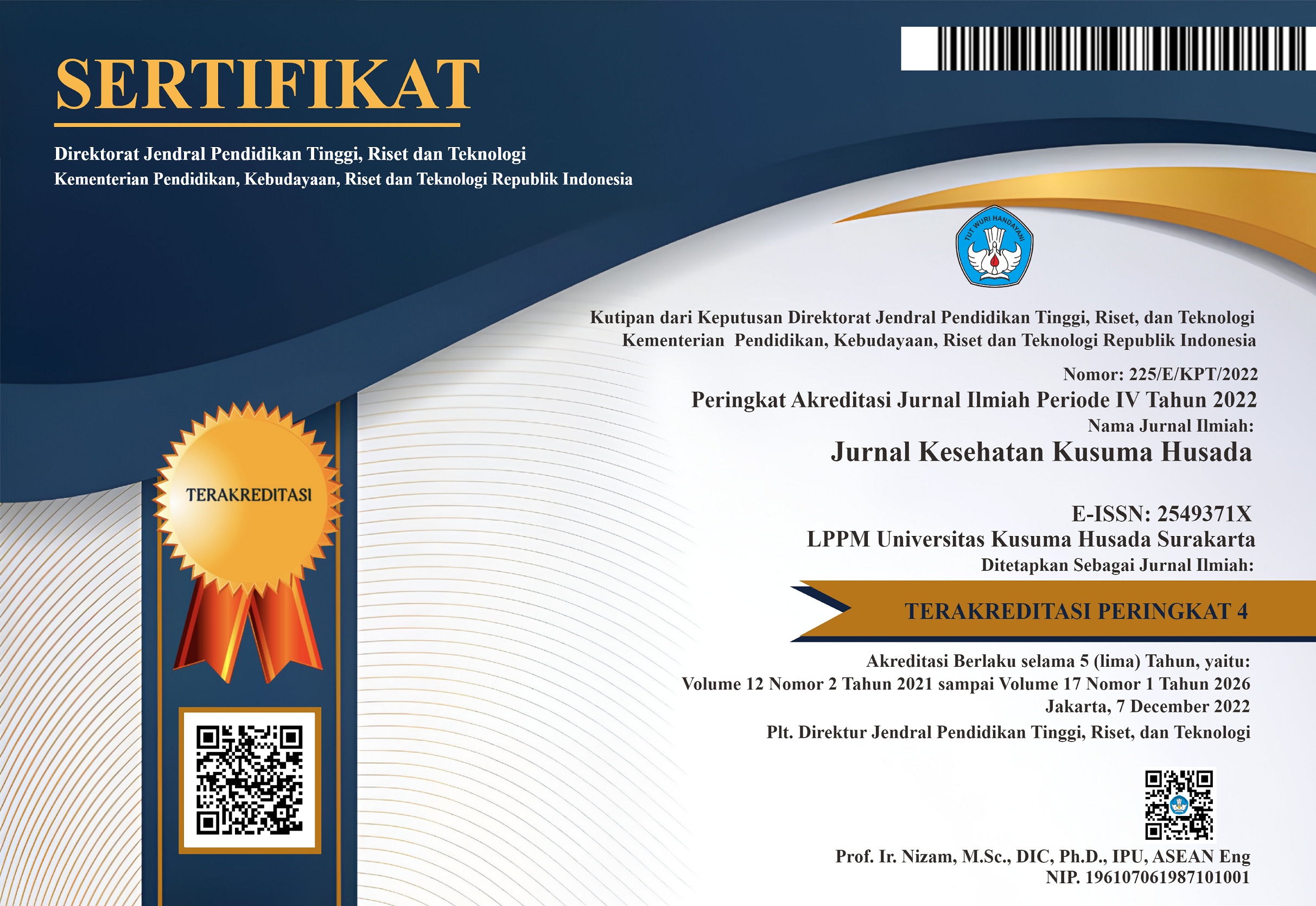HUBUNGAN SIKAP DAN PERILAKU KADER MENURUT IBU YANG MEMPUNYAI BALITA TERHADAP FREKUENSI PENIMBANGAN BALITA DI POSYANDU KECAMATAN TERAS BOYOLALI
Abstract
ABSTRAK
Di dalam Renstra Kementrian Kesehatan 2010- 2014 dan Instruksi Presiden No 3 tahun 2010 telah ditetapkan bahwa tahun 2014 sekurangnya 80% anak ditimbang secara teratur di Posyandu. Pencapaian kegiatan pemantauan pertumbuhan pada tahun 2011 adalah 71,4% dan beberapa provinsi telah mencapai di atas 80%, sedangkan di sebagai propinsi masih dibawah 80%, di Jawa Tengah presentase kunjungan balita ke posyandu adalah 79,2%. Tujuan penelitian untuk mengetahui hubungan sikap dan perilaku kader menurut ibu yang mempunyai balita terhadap frekuensi penimbangan balita ke Posyandu kecamatan Teras Boyolali. Jenis penelitian merupakan explanatory research. Pendekatan yang digunakan adalah Cross Sectional. Sampel yang digunakan adalah ibu yang mempunyai balita di Posyandu Kecamatan Teras Boyolali sejumlah 65 responden. Instrumen yang digunakan adalah kuesioner yang sebelumnya dilakukan uji validitas dan reliabilitas. Hasil analisis data menunjukkan ada hubungan antara sikap kader dengan frekuensi penimbangan balita. Hasil analisis chi square menunjukkan bahwa nilai X2 hitung (3,968) > X2 tabel (3,481), dengan (df=2-1=1) dan nilai sig.(0,049) ≤ (0,05). Ada hubungan antara perilaku kader dengan frekuensi penimbangan balita. Hasil analisis chi square menunjukkan bahwa nilai X2 hitung (6,764) > X2 tabel (3,481), dengan (df=2-1=1) dan nilai sig.(0,034) ≤ (0,05). Ada hubungan antara sikap kader dan perilaku kader terhadap frekuensi penimbangan balita. Hasil nilai Nagelkerke sebesar 0,167 yang berarti 16,7 persen variasi dari frekuensi penimbangan balita dapat dijelaskan oleh sikap dan perilaku kader, sedangkan sisanya sebesar 83,3% diterangkan oleh variabel lain di luar variabel penelitian ini.
Kata kunci : sikap, perilaku,kader, frekuensi, penimbangan balita
ABSTRACT
In the Ministry of Health Strategic Plan 2010- 2014 and Presidential Instruction No. 3 of 2010 has established that by 2014 at least 80% of children were weighed regularly in Health Care. Achievement of growth monitoring activities in 2011 was 71.4% and some provinces have achieved above 80%, whereas in a province is still below 80%, in Central Java, the percentage of visits to neighborhood health center infants was 79.2%. The aim of research to determine the relationship of attitudes and behavior of cadres according to mothers with toddlers on a child’s weight to neighborhood health center sub-district Teras,Boyolali . This type of research is an explanatory research. The approach used is Cross Sectional. The samples used were mothers with infants in Health Care, Teras Boyolali District of the 65 respondents. The instrument used was a questionnaire previously tested the validity and reliability. The results of data analysis showed no relationship between attitude cadre with frequency child’s weight. The results of chi square analysis showed that the value of X2 count (3,968)> X2 tabel (3.481), with (df = 2-1 = 1) and sig. (0,049) ≤ (0.05). There is a relationship between the frequency of the behavior of cadres with a child’s weight. The results of chi square analysis showed that the value of X2 count (6.764)> X2 tabel (3.481), with (df = 2-1 = 1) and sig. (0.034) ≤ (0.05). There is a relationship between the attitude of cadres and cadres of the frequency behavior of a child’s weight. Results Nagelkerke value of 0.167, which means 16.7 percent of the variation of the frequency of a child’s weight can be explained by the attitude and behavior of cadres, while the remaining 83.3% is explained by other variables outside of the study variables.
Keywords: attitude, behavior, candidat, frequency, weighing tod
The copyright of the published articles belongs to Jurnal Kesehatan Kusuma Husada.

This work is licensed under a Creative Commons Attribution 4.0 International License.











